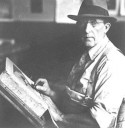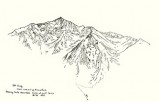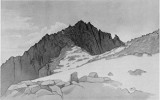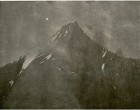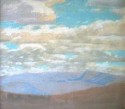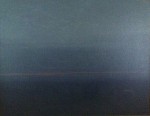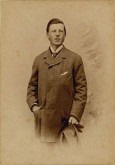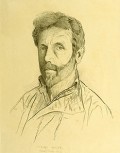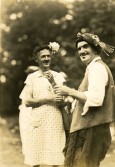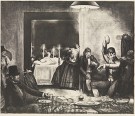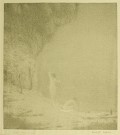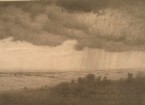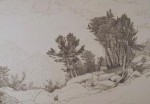The browser will either open the file, download it, or display a dialog.
Bolton Coit Brown (1864–1936; fig. 1) is best known as one of the founders of what would come to be called the Woodstock Art Colony, still an active community of visual artists, musicians, literati, and disenchanted New Yorkers in the Catskill Mountains. Brown was a painter of eloquent tonal effects, a technically unsurpassed lithographer, and an expert-level mountaineer, exploring and naming a new group of peaks in the Sierra Nevada range of California. He was also responsible for a substantial written output—multiple books and essays on painting and lithography, articles on climbing, memoirs, journals, and letters—the result of being an agile and persuasive writer, as well as intellectually self-assured. This latter quality sometimes had dire consequences. As will become clear in this brief overview, Brown’s identity was forged from an intersection of his intensive mountain climbing, his art, and his writing, a tripartite creative project merging physical, visual, and literary expression. As a climber, Brown achieved the first recorded ascents of some of the highest summits in nineteenth-century American mountaineering history, first ascents constituting a genre of authorship in which blazing new trails and being credited in a guidebook are trivial alongside more esoteric feelings of discovery and origination. As an artist and writer, Brown kept detailed visual and literary records of these bold expeditions, turning his creative physical achievements into narrative ones. Later in life, when age prevailed over his skills as a mountaineer, Brown took to inventing new lithographic processes, writing three book-length studies of the medium and codifying his experiments in twelve tightly-penciled volumes that reveal the authorial precision of an explorer keeping a log of his travels. Finally, and importantly for Brown’s identity as both artist and climber, it will be shown that he derived as much pleasure from the physicality of lithography, its reliance on manual labor, muscles, and stone, as from the finished results. His mountaineer’s lifestyle found an ultimate expression in his creative endeavors, with the artistic and the athletic translating into interchangeable ways of seeing.
Stanford and Mount King: Falling, Summiting
Brown was raised in upstate New York. He received his Master’s degree in painting from Syracuse University, then moved to California in 1891 to head the art department of the newly-formed Stanford University.[1] He held this position for almost ten years, the most stable period in a career characterized by frequent financial vulnerability. But Brown was fired from Stanford in 1900. Having been told that he could not use nude models in coed classes, Brown fought back in a letter to University President David Starr Jordan, making clear that he had no tolerance for questions of morality infiltrating his pedagogical sanctum:
I have never seen a look of consciousness or shame on any student’s face. . . . The other day—after orders had been given me . . . I told them [that] the boys and girls must separate to draw that woman there. And then—for the first time—I did see shame on their faces. . . . The false attitude and the impurity of the false and the impure had been thrust upon those whose attitude was right and whose thoughts were pure.[2]
Here Adam and Eve are tacitly, though facetiously, summoned. Brown was an adamant atheist and battled his father, a Presbyterian minister, all his life.[3] Soon after Brown had sent his letter, Mrs. Stanford ruled that nude models could not be used even in separate-sex classrooms, and Brown was forced out for refusing to abide.[4] This was not to be an isolated occurrence in his career. He left telling Jordan what Stanford stood to lose: “To the best of my knowledge and belief, I am now the best teacher of art in the United States. This is not a boast, but a judgment. … I happen to have been born with gifts that enable me to do it—that’s all.”[5]
This unapologetic self-importance was typical of Brown, an argumentative, anti-social colleague by nearly all accounts.[6] While it did not save his job at Stanford, Brown’s brawny ego translated into the life-preserving confidence required to climb well. His Stanford years provided the opportunity to explore the nearby Sierra Nevada mountains, best known as the domain of explorer and naturalist John Muir (1838–1914), who founded the Sierra Club in 1892. Muir’s writings on Yosemite and the High Sierra, duly examined by the well-read Brown,[7] are famed for their Proustian paeans to every petal and type of bark characterizing indigenous varieties of flower and sequoia. Muir was an intrepid climber but a self-effacing writer, only subtly referencing his first ascents.[8] Instead he confesses to his fear of heights, recurrent dreams about falling, and thoughts of death in the mountains—the latter, in the aesthetic spirit of the sublime, something he seems to have relished.[9] Conversely, Brown’s expedition reports published in the biannual Sierra Club Bulletin are action-filled tales of personal heroism and creative problem-solving. He was unwittingly a founding contributor to today’s journalistic subculture of climbing magazines, which combine mountaineering prowess, esoteric route descriptions, and travel anecdotes. In an 1897 article in the Sierra Club Bulletin, Brown indulges in a popular brand of adventure-magazine anecdote, pitting “bona fide mountaineers” against tourists. He tells of a group visiting the Sierra’s lower elevations, among them “those ladies wearing big hats with mosquito netting over them,” who met with a grizzly bear while out for a stroll. Eternally intolerant and ornery—but often funny—Brown concludes that “for the story’s sake, it is too bad the bear merely turned around and went back up the trail.”[10] For thrill-seekers, Brown’s Bulletin articles are replete with death-defying moments and swaggering displays of the superhuman. He reminds readers at regular intervals of his “being in perfect training” and how climbing made him feel “like a fighting-cock”[11]—an apt metaphor for Brown’s combative and proud temperament. His pride was not, however, without justification: Brown’s mountaineering feats were spectacular. His most challenging first ascent was of Mount Clarence King (12,905 feet) in August of 1896:
Some five hundred feet below the summit, I could look over its eastern shoulder—a look which quite gave me a qualm—it being absolutely sheer for more than a thousand feet beneath. . . . Poised on a narrow ledge, I noosed the rope and lassoed a horn of rock projecting over the edge of the smooth-faced precipice overhead. But a pull on the rope toppled the rock bodily over, nearly hitting me, who could not dodge. So I took out the noose, and having tied a big knot in the rope-end, threw it repeatedly until this caught in a crack, when I climbed the rope. . . . I finally looped the rope over an all-too-slight projection . . . and compelled myself to put one foot in it and lift myself, and so stand, dangling in that precarious sling, until I could get my arms on the top and squirm over.[12]
Brown’s description of loops and knots demonstrates specialized aid-climbing knowledge. Steve Roper, author of the definitive Climber’s Guide to the High Sierra, proposes that Brown was the first to use these rope techniques in North America, concluding “this solo adventure was the finest Sierra climb of the nineteenth century.”[13] His route on Mount King, a classic to this day,[14] involves vertical rock climbing as opposed to just steep hiking (which characterizes most of Mount Everest).[15] Brown’s technical proficiency is further indicated by his climbing barefoot, enabling him to use footholds too small for a heavy boot.[16] He was commemorated in 1922 by two climbers who gave the name Mount Bolton Brown to a 13,538-foot Sierra peak. But they had to claim their route without actually standing on the true summit, the last few feet consisting of a razor edge as abrupt and unapproachable as Brown himself could be: “It was impossible to stand on this splinter. We patted it affectionately.”[17]
Picturing Mountains
First ascentionists usually have the creative privilege of naming their summits, although the remote Mount King had been named prior to any attempts at climbing it.[18] Brown was also the first to record having climbed (including two summits with his bold wife of 16 years, Lucy) and named the Sierra’s Mount Ericsson, Arrow Peak, Mount Gardiner, Mount Stanford, and Mount Ruskin.[19] It is unsurprising that he would pay homage to the legendary aesthetician and devotee of mountain scenery John Ruskin (1819–1900), whose Elements of Drawing and parts of the ponderous Modern Painters he read in his youth.[20] Brown dutifully references Ruskin throughout his voluminous writings. In 1887 and 1888, following in Ruskin’s footsteps, Brown climbed in the Alps, which Ruskin famously cherished. While abroad he also visited the museums of Florence, London, and Paris, and wrote home synopsizing the history of European art: Giotto could do no wrong; Turner was not as infallible as Ruskin would have readers believe, though Brown loved his sketches and watercolors; and the French painted far too many nudes, having “worn the theme dreadfully threadbare.” Brown produces an exhaustive list of quintessential nude-woman activities: “she 'siestas’ on the bed,” “toys with little cupids in the garden,” “wanders disconsolate in the woods,” “bemoans herself by the seaside,” or “flies from pursuing warriors.” He enumerates twice as many hackneyed postures, concluding that the modern nude is inferior to her classical ancestors because of “unintelligent Realism.”[21]
Brown’s commemorative naming of the 12,920-foot Mount Ruskin in August of 1895 was rooted in Ruskin and Brown’s shared attachment to the physical sensations and psychological states brought about by contemplation and exercise in the mountains. Although not as skilled or adventurous a climber as Brown, Ruskin had a respectable resume of Alpine treks and made countless sketches of mountain scenery during his outings.[22] Brown likewise kept assiduous visual records of his climbing expeditions; when packing his knapsack with a mind to efficiency and lightness, sketching materials were bare essentials, along with food and water. Included in his reports for the Sierra Club Bulletin are detailed trail maps and topographical drawings of the mountains he climbed, intended as guides to readers who would be the Sierra’s future explorers. In his drawing Mount King from the Summit of Arrow Peak (fig. 2), specific features of rock faces, secondary summits, couloirs and crags are painstakingly delineated, their minutia key to route-finding. A dotted line, easily traced following the description in the article text, indicates the trail Brown created through notches and across ridgelines and snow fields. He also did detailed wash studies of the Sierra, such as Mount Brewer (fig. 3). In these, deep ink lines exaggerate every fracture and arête, while unnuanced light and shadow emphasize rock buttresses and corners. A calculated lack of atmospheric realism results in ultra-clear, geologically precise but visually improbable images. These are predecessors to modern-day climbing “topos,” or guidebooks, which even now rely fundamentally on drawing rather than photography. Because a camera lens cannot focus on and magnify all rock features simultaneously, photography is incapable of translating a particular mountain route into a legible picture. But such visual omniscience is crucial to mountaineers trying to establish their bearings by reading the rock. Despite its limitations as a climbing tool, Brown experimented with photography, endlessly motivated to learn new image-making techniques. When undertaking what would be his last excursion in the Sierra, he was undaunted by the laborious process of rope-hauling a full photographic outfit up the mountain: two turn-of-the-century cameras, a tripod, and 24 glass plates.[23]
Brown the visual artist and Brown the strategic mountaineer pooled resources in his Sierra Club Bulletin drawings and his wash studies, creating images of a genre Ruskin generically deemed topographical as opposed to artistic. In Ruskin’s definition of artistic landscape, the painter recreates “not the facts of it, but the impression it made on his mind . . . the far higher and deeper truth of mental vision.”[24] If indeed Brown’s Bulletin illustrations are stoic reference material rather than poetry, he would divulge his “higher and deeper” mental impressions in the written texts they supplemented. When not outlining practical details, Brown’s Bulletin articles are characterized by an expressive ability to verbalize visual effects and the abstract patterns found in nature. En route to the summit of Mount King, he watched the moonrise, vividly describing the phenomena of lighting in the mountains:
First came the paling of the stars, then the glow behind the mountain wall, then a spark — one sharp fire-tip on its vast black rim,—then steadily — “Not slower than majesty moves for a mean and a measure Of motion; not faster than dateless Olympian leisure Might pace with unblown ample garments from pleasure to pleasure,”—the mountain sinks, and the moon climbs, its radiance touching with silver the rivulet below, chalking one side of every rock, and flooding with its weird light wide ranges of lonely mountains.[25]
The text offset by quotation marks (from “Not slower” to “pleasure”) is Brown interpolating, with no introduction, three lines from Sidney Lanier’s poem “Sunrise.”[26] Without pause, he resumes his own description as if poetic paroxysms of this sort are to be expected in such breathtaking settings. The result is simultaneously lyrical and confusing.
Brown’s reports in the Sierra ClubBulletin reveal that, even more than by the effects of mountain lighting, he was seduced by the lack of clarity associated with atmosphere and altitude, the subdued tonalities and hazy outlines of mountain landscapes—alluring qualities he had to resist in his topographical drawings if they were to be functional. Upon reaching the summit of Mount Williamson with Lucy, he wrote:
Gazing off into the immense pale distances of mountain and plain . . . we marveled at that magic of atmosphere and light and distance which could transform mere flat earth and barren mountain into these enchanting visions of ravishing beauty. . . . Owens Lake stretched its vast surface of heavenly blue; and, wide as it is, so great was our height that whole topographies of mountain ranges and wide plains beyond it lay piled up into the sky in level layers, and lost themselves along the immensely remote and hazy horizon.[27]
Like the blurred boundaries between the poetic voices of Lanier and Brown in his composite narration of the moonrise, Brown admires how individual landscape components become lost and layered in mountain views. With these conceptual aspects as his artistic foundation, Brown’s Sierra paintings are the visual opposites of his illustrations. An unlocated painting of the Summit of Mount King (fig. 4) at dusk has a dense arm of fog reaching from the upper left and obscuring the mountain’s profile as it tumbles into the foreground. As in his written description, the moon begins to “chalk” the rock contours as it rises. In an untitled oil of Sierra scenery (fig. 5), Brown created a tonal and structural abstraction built from three horizontal layers of muted color. The top-heavy register of sky naturalistically imitates the repetitive parallelism of stratus cloud formations, setting up the stratified patterning of the composition as a whole. In the painting’s central register, the gray, pink, and black-speckled granite of the Sierra is transformed into purple punctuated by ultramarine blue—the dominant tonalities of any high peaks viewed through the lens of atmospheric perspective. Ruskin pays lengthy tribute to the specialized violets and purples of mountains seen from afar, concluding that people who have never visited the mountains cannot possibly conceive “the grave tenderness of the far-away hill-purples.”[28] The bottom register, a mottled olive green, creates a shorthand reference point for near versus far. Based on minimalistic fields of contrasting color, Brown puts forth a synopsis of what vision looks like in the mountains. During his most aggressive exploration of painting between 1905 and 1915, he produced more characteristically tonalist paintings such as Morning Rose Bars (fig. 6), in which an almost entirely monochromatic image captures the sensual blurring created by atmospheric effects.
Seeing Like Ruskin
In 1913 Brown published a book on color theory, although with characteristic sententiousness, he pointed out that it “contains nothing whatever in the way of a 'color theory’ . . . not theory, but fact.”[29] It lends insight into his pictorial experimentalism at this period of his career, when he was thinking scientifically but, as paintings like Morning Rose Bars make clear, with no interest in representation for its own sake. “All painting is done from memory,” he wrote, “What we call thinking is really a recalling of certain elements of sense-impression: that the thought-world was in truth simply an abstraction from the external world and that the processes that take place in our minds are but imaginings of sensuous experiences.”[30] At its most theoretical, Brown’s writing is heavily indebted to Ruskin, while his specifically mountain-oriented narratives (both visual and verbal) share Ruskin’s fascination with the optical instability of mountain scenery. Asymmetrical and jagged-edged, comprised of irregular features and obscured from one moment to the next by the variables of atmospheric perspective, mountains are never fully available to the eye, presenting ready-made abstracted “sense-impressions.” As a result, they cannot be precisely recorded by the intellect or memory. Ann C. Colley argues that Ruskin aesthetically privileged mountain vistas because their inherent unavailability as a visual whole paralleled his imperfect vision due to what are commonly known as “floaters”—spots or threads that disturb the field of vision. Technically harmless but usually without cure, they were a source of distress for Ruskin.[31] With the aid of spectacles, Brown’s vision remained acute all his life, but like Ruskin he was attracted to the indistinct edges and blurred atmospheric qualities of the mountain landscape, and its demands on the artist to create something beyond imitation. His interchangeable points of view as both mountaineer and artist, however, helped him to reverse the process to create hyper-representational—that is to say, unrealistically so—topographical drawings that would serve as guides to future mountaineers.
The expressively modernist vision of both Brown and Ruskin is bound to a complex nineteenth-century discourse on landscape painting. Though such an expansive dialogue is a matter for several articles unto themselves,[32] one thing is key: neither for Ruskin, nor Brown, nor the Impressionists, nor any other artist who turned to nature for subject matter, was “realism” ever the point, although claims to the contrary are an inevitable line in the conversation. Brown writes of a large oil sketch he did on site of a mountain landscape:
I was thoroughly disgusted with the thing . . . and scraped it all off with my palette knife. . . . [I then] began daubing on the scrapings . . . and took a big brush and mixed my colors on the wet paint with no pretense at copying what was before me. I set the result against a stone and stepped back to look at it and was very much puzzled when it dawned on me . . . without an effort, almost without a thought, I could do a sketch which I have hardly ever equaled.[33]
With “no pretense at copying” and “without a thought,” Brown’s picture-making process produced pure Ruskinian artistic truth: sourced from the imagination rather than copied outright, and discovered by the artist only when he, in Ruskin’s words, “does not think at all.”[34] The skilled mountain painter (which in the broad-minded Ruskin’s paradoxically limited roster meant Turner alone) depicts “not so much the image of the place itself, as the spirit of the place.”[35] This has obvious affinities with Jules-Antoine Castagnary’s iconic 1874 description of the Impressionists’ painting “not the landscape, but the sensation produced by the landscape”[36] or Stéphane Mallarmé’s poetic aim to “paint not the thing itself, but the effect it produces”[37]—each an attempt at verbalizing the divide between representation and the psychological imprint left behind by reality. In a remarkable excerpt from My First Summer in the Sierra, John Muir would point to the effects of mountain beauty on his ability to record how things really looked:
Sketching on the North Dome . . . I would fain draw everything in sight — rock, tree, and leaf. But little can I do beyond mere outlines, — marks with meanings like words, readable only to myself, — yet I sharpen my pencils and work on as if others might possibly be benefited. . . . Little can [these drawings] tell to those who have not themselves seen similar wildness, and like a language have learned it.[38]
Ruskin, Brown, and Muir sought to adapt their pictorial language to the geologic, atmospheric, and emotional idiosyncrasies of mountain scenery—a specialized visual arena that did not permit, and warranted more, than the scientific trappings of, as Brown had called it, “unintelligent Realism.”
Woodstock
The entirety of Modern Painters’ fourth volume is dedicated to the mountains, with which Ruskin had a personalized aesthetic bond. Interested in the psychological effects of mountain living, he postulated a causal relationship between creative inspiration and altitude, which has the “gift of exciting, in peculiarly solemn tones, the poetical and inventive faculties.”[39] With these theories as his point of departure, the progressive aristocrat Ralph Radcliffe Whitehead (1854–1929; fig. 7) decided upon a minimum elevation of 1500 feet[40] for what he and his wife would name Byrdcliffe, the Woodstock Art Colony’s earliest manifestation.[41] Whitehead had attended Ruskin’s lectures at Oxford in 1873, traveled to Italy to visit him, and ultimately formulated a brand of Ruskinian social consciousness that entailed sharing his wealth in support of the arts. [42] He approached Bolton Brown to help build the Byrdcliffe Arts and Crafts Colony in 1901, when they both lived in California. Brown describes their initial meeting as a discussion of “art in general and art in particular.” This no doubt included Ruskin, who had died the year prior. Their intellectual common ground and Brown’s skills as an artist and outdoorsman appealed to Whitehead, whom Brown managed to talk into three times his proposed salary.[43] He had recently lost his Stanford job and had three children to support, but was able to remain strong-willed even in times of need.
Brown’s first order of duty under his new supervisor was to search nationwide for a mountainous location suitable for Byrdcliffe. Returning to his home state of New York, he spotted the small village of Woodstock from the summit of Overlook Mountain and convinced Whitehead to build the colony there.[44] Whitehead meanwhile had also hired Hervey White (1866–1944; fig. 8), a long-haired, long-bearded poet and social reformer who graduated from Harvard.[45] Byrdcliffe’s buildings and grounds were rapidly constructed under Brown’s supervision, and artists made their way to Woodstock. Brown assumed that as at Stanford, he would head Byrdcliffe’s art school, and reacted poorly to learning that Whitehead had planned that he be only a drawing instructor. Finding Brown’s hubris unmanageable, Whitehead gave him notice. Of this Brown wrote: “When he found in me a disposition to stand for my ideas, he said I 'mistook my position.’”[46] This disposition had of course also proved fateful at Stanford. But Brown’s propensity for outspokenness—at all costs standing by what he believed was truth—identifies in him part of the personality archetype for the Woodstock of Bob Dylan’s days. Another part of the Woodstock archetype was embodied in Hervey White, who remained at Byrdcliffe briefly after Brown’s dismissal. He seceded in 1904 to establish a separate colony nearby, the Maverick. By the 1920s, White’s Maverick Colony exemplified the very real, though seemingly mythical, Woodstock ethos: a dreamy land of partying intellectuals with flowers in their hair (fig. 9). Brown had feared this was the direction Whitehead would take Byrdcliffe: “His thought was a happy go-lucky Bohemia. My thought had little to do with Bohemia but a lot to do with understanding your job and working at it.”[47] But Brown was a dreamy radical in his own way.
After splitting with Whitehead, Brown moved between New York City and teaching privately in Woodstock, where he had to compete with the successful Impressionist painter Birge Harrison and the summer art school of the Art Students League.[48] Brown’s advertisement for his classes gives equal space to his teaching material and the idyllic physical situation of his Woodstock studio: “The climate is salubrious and pleasant. No mosquitoes . . . Mountain climbing immediately to the north and west.”[49] That students could climb in the Catskills was no minor detail for Brown. Nor was it a mere convenience that the Catskills supposedly had no mosquitoes which, in Brown’s Sierra Club Bulletin narratives, are categorized alongside the ladies and their mosquito-netting as rare hindrances to his mountain euphoria.[50] Whether mosquitoes, tourists or, with the most trying results, employers like Mrs. Stanford or Whitehead who impeded his autonomy, Brown was plagued by anything that signified a loss of control over his surroundings—by anything but solitude.
Lithographic Stone and Nostalgia
Able to sustain a working relationship with next to no one, Brown spent the rest of his life destitute and alone, his marriage with Lucy coming to an end around 1912. He suffered a brief depression,[51] but idleness was not in his realm of possibilities. Brown instead became absorbed in learning lithography, the aspect of his art into which he poured the greatest intellectual and physical energy, both as printmaker and theoretician. He published several books and articles on the subject, invented new processes and crayon formulas, and filled twelve volumes with mathematical and chemical calculations.[52] Brown’s lithographic expertise became evident to the public when he was the printer for the prominent Woodstock artist George Bellows (1882–1925), whose early death ended a productive business relationship and friendship (fig. 10). In addition to printing for Bellows, John Sloan, and others, Brown created over 400 lithographs of his own,[53] focusing on nature and female nudes (ironic in light of his belief that the French had exhausted the subject). In images such as Moonlight Bathers (fig. 11), he experimented with the lithographic possibilities of creating impressionist/tonalist effects of atmosphere and shadow, while Summer Shower (fig. 12) impressively imitates the vertical patterning of rain seen from a distance. Brown set out to demonstrate that the lithographic stone, better than any other surface, encouraged these effects: “On stone you can do any and all of these things,” he wrote, “the moth, the figure, storm clouds and filmy veils—nothing is denied you.”[54] Many of Brown’s lithographs return to the subjects of his Sierra Club Bulletin drawings from 20 years prior, underscoring his lifelong attachment to his identity as a climber while allowing him to emphasize the contemplative, atmospheric qualities of the mountains, as in his paintings. Two Peaks (fig. 13) demonstrates the versatility of the lithographer’s touch both when drawing on the stone and when preparing it for printing. The pale linearity of the mountains evokes the optical paradox of hard-edged granite made soft by atmosphere—one of Brown’s deepest visual attachments to the mountains, but avoided in his pragmatic Bulletin drawings. Ohayo Mountain (fig. 14) exemplifies his more spontaneous lithographic style, while the vivid hatch-marks footnote his experience as an etcher.[55]
In 1915, Brown went to England and spent the year studying lithography with F. Ernest Jackson. He set up his own lithographic press when he returned to Woodstock,[56] where he remained for most of the rest of his life.[57] As he became more involved with lithography, he lost twelve pounds and “gained two inches across the chest” [58] from hauling heavy limestone slabs around his studio and, notoriously, about town in a wheelbarrow that doubled as an easel. But he savored the positive effects of this labor: “Once hardened to it . . . I came out in a condition for a prize fight: weight down, hard as nails, feeling like a rubber ball.”[59] The muscular strenuousness of lithography was, for a fit man who prided himself on his physical power, as exhilarating as the printed yield. Brown would write in his Lithography of 1923: “Art is not merely visual: partly it is, as Ruskin declared, athletics.”[60] Likewise for Brown the mountaineer, deft movements and the creative elements of route-finding were as important as reaching the summit[61] where, ultimately, the visual trumped the physical. Bodily and mental exertion gave way to endless pictorial rewards.
Brown’s writing on lithography is technique-oriented, with case studies analyzing processes and their results. The overarching theme is that lithography depends on neither paper nor ink, but on the lithographic stone where the original drawing is created—or should be created. He was adamantly opposed to transfer lithography, in which a drawing is made on paper then transferred to the stone for printing. This method was regularly used by well-known artists like James McNeill Whistler because, Brown wrote, paper is more physically manageable than stone and a drawing surface to which artists were more accustomed.[62] But Brown argues that “stone – the most perfect of surfaces”[63] receives the marks of the lithographic crayon naturally, citing the prehistoric cave paintings at Altamira as proof of a primordial, organic relationship between the artist’s hand and the physical qualities of stone.[64] Brown’s lithographic interests are heavily inflected with sentimentality for the tactile qualities of rock, paying tribute to the surface of the lithographic stone with the same nostalgic geological nuance as a climber describing a hand or foothold.[65] For example, the lithographic limestone’s “texture, viewed through an imaginary microscope, is an array of points of stone—small indeed, but amazingly real and reliable when you deal with them.”[66] And here he is describing a granite climbing surface: “studded with bits of sharp crystals and the projecting edges of little lines of quartz . . . I suppose an inch or two of solid rock is as safe as a yard or two—but somehow you just don’t feel the same about it.”[67] In both cases, he defines the stone in terms of a personal set of criteria for usefulness. Lithography and rock-climbing were interconnected expressive mediums for Brown, each demanding scientific knowledge, methodical patience, and attention to a systematic interdependency of details lest the whole operation fail.
Charting a Course for Posthumous Fame
Brown’s unsociable nature and disregard for diplomacy had a forcible impact on his marketability as an artist, and he sold very little during his lifetime. Today, he is well-known to only two populations: historians and collectors of the Woodstock Art Colony, and climbers. He knew that “as a propagandist I fell short”[68] and even took mischievous pleasure in aggravating art critics.[69] But all the same, Brown blamed their shallowness rather than his own lack of savvy for public relations: “It seems an unfortunate fate to have tried so hard and so long to paint well enough to be worthy of my public, and then to find that instead of hitting that public taste, I paint way over their heads.”[70] He would say the same of his lithographs: “They go rather over the heads of the average public.”[71] This syndrome-like superiority takes on dense pathos in a poem published in 1918 in Hervey White’s Maverick publication The Plowshare, in which Brown describes himself as “sitting alone, high in my tower far above the town,”[72] evoking his lofty self-image, his solitude, and his love of altitude. It is difficult, all told, to say that he was dissatisfied: poor yes, lonely maybe, but his intellect and hands were frenetically active until the end. Knowing death was near, Brown even incised the dates on his own grave-marker: an unadorned boulder which, in keeping with his deep attachment to the particularities of stone, he had transported from his yard to the Woodstock Artists’ Cemetery. Hailing the boulder’s “size, its hardness, and the beauty of its form and surface—created by nature,” Brown wrote to a friend: “But my real monument is not of stone . . . it is the lifetime of work that I have done—and left behind me.”[73] On a page of his journals where he transcribed a telling selection of quotes, Brown excerpts the following from Daniel Halévy’s Life of Nietzsche: “Doubtless it is a very old story, the constant, the universal, the irremediable misadventure of the unrecognized genius because he is a genius, a novelty, a surprise, a scandal.”[74] Misadventure and scandal were surely undercurrents in Brown’s professional dealings; a genius, he clearly felt comfortable claiming to be; and as for unrecognized, Brown planned for that to be remedied posthumously, writing his memoirs, keeping an assiduous correspondence with family, starting an autobiography at an advanced age, [75] annotating his journals with explanations of what certain abbreviations mean, and carefully cataloguing his entire lithographic output. Like a mountaineer charting a route for later explorers to navigate, Bolton Brown made certain to leave historians with a clearly-marked trail. He was always aware that he was building not just a body of work, but an archive and an identity, as if modeling his pictorial, written, and mountaineering accomplishments on a pre-planned, “life and work” biographical mode. Analyzing his productivity as a writer—“Compilations show,” he noted, “that I write about 150 words a day”[76]—Brown had a mathematical, methodical approach to everything, including mapping a historical self.
[1] Clinton Adams, Crayonstone: The Life and Work of Bolton Brown (Albuquerque: University of New Mexico Press, 1993), 16–17, 34. Adams’s book is indispensible for its insight and as a compilation of dispersed archival material that is otherwise difficult to access.
[2] Bolton Brown to David Starr Jordan, January 1900, quoted ibid., 44–46.
[3] Brown’s relationship to religion is detailed in “How I Shed Religion,” an essay appended to his memoirs. See Bolton Brown, Boyhood Memories of Bolton Brown, ed. Marian S. Sweeney (Watkins Glen: Free Public Library, 1986), 115–27. The work is a completed memoir published posthumously.
[4] Adams, Crayonstone, 47–48.
[5] Bolton Brown to David Starr Jordan, January 1900, quoted ibid., 47.
[6] John Taylor Arms, who studied lithography with Brown, gave this a positive spin: “A strong man, with strong convictions . . . when he expressed an opinion it was founded on study and knowledge and was therefore well worth hearing.” John Taylor Arms, Bolton Brown, The Artist and the Man, 1937 memorial brochure reprinted in Bolton Coit Brown: A Retrospective, exh. cat. (New Paltz: Samuel Dorsky Museum of Art, SUNY, 2003), 83.
[7] For example, Bolton Brown, “Another Paradise,” Sierra Club Bulletin 3, no. 2 (1900): 135.
[8] Muir’s first ascents in the Sierra are Mount Ritter and Cathedral Peak. Steve Roper, The Climber’s Guide to the High Sierra (San Francisco: Sierra Club Books, 1976), 334, 336.
[9] For example John Muir, My First Summer in the Sierra (1911; repr.,Boston: Houghton Mifflin, 1944), 120–21, 123.
[10] Bolton Brown, “Wanderings in the High Sierra, Between Mt. King and Mt. Williamson, Part 2” Sierra Club Bulletin 2, no. 2 (1897): 90–91.
[11] Bolton Brown, “A Trip about the Headwaters of the South and Middle Forks of King’s River,” Sierra Club Bulletin 1, no. 8 (1896): 312–13.
[12] Brown, “Wanderings in the High Sierra, Part 2,” 95–96.
[13] Roper, Climber’s Guide, 247.
[14] See for example Bob Burd, "Mount Clarence King," Summitpost.org, last modified February 26, 2006, accessed January 24, 2012, http://www.summitpost.org/mount-clarence-king/150502.
[15] Mount Everest (first ascent 1953) is the world’s highest mountain, but not the most difficult. One technical section, the Hillary Step, is surmounted using ropes fixed by mountain guides. The relative accessibility of Everest has encouraged a tourist trade resulting in climbers finding themselves in serious trouble. See Jon Krakauer, Into Thin Air (New York: Doubleday, 1997).
[16] Brown, “Trip about the Headwaters,” 307. Muir also makes reference to climbing barefoot. Muir, My First Summer, 196.
[17] Chester Versteeg, “The Peaks and Passes of the Upper Basin, South Fork of the Kings River,” Sierra Club Bulletin 11, no. 4 (1922): 426.
[18] The peak was named after Clarence King, author of Mountaineering in the Sierra Nevada (1872). Brown accused King of cowardice for deeming impossible any climb he was not able to do himself. Bolton Brown, “Wanderings in the High Sierra between Mt. King and Mt. Williamson, Part 1,” Sierra Club Bulletin 2, no. 1 (1897): 26 (in Brown’s footnote).
[19] Roper, Climber’s Guide, 356–60.
[20] Brown, Boyhood Memories, 98.
[21] Letter from Brown to his parents, August 18, 1887, quoted in Adams, Crayonstone, 22.
[22] Ann C. Colley, “John Ruskin: Climbing and the Vulnerable Eye,” Victorian Literature and Culture 37, no. 1 (2009): 44–46.
[23] Bolton Brown, “A Glimpse of the Winter Sierra,” Sierra Club Bulletin 3, no. 3 (1901): 245.
[24] John Ruskin, Modern Painters, ed. David Barrie (New York: Alfred A. Knopf, 1987), 439–41.
[25] Bolton Brown, “Three Days with Mount King,” Sierra Club Bulletin 1, no. 7 (1896): 246.
[26] Sidney Lanier, Poems of Sidney Lanier, ed. his wife (New York: Charles Scribner's Sons, 1884), 3–10; online at Documenting the American South, University Library, The University of North Carolina, last updated March 8, 2012, accessed March 8, 2012, http://docsouth.unc.edu/southlit/lanier1/lanier.html#lan3.
[27] Brown, “Wanderings in the High Sierra, Part 1,” 26.
[28] Ruskin, Modern Painters, 470–71.
[29] Bolton Brown, The Painter’s Palette and How to Master It (New York: The Baker and Taylor Co., 1913), 5.
[30] Ibid., 6, 9.
[31] Colley, “John Ruskin: Climbing and the Vulnerable Eye,” 46–66.
[32] Some important texts include: Stéphane Mallarmé, “The Impressionists and Edouard Manet,” Art Monthly Review and Photographic Portfolio 1, no. 9, September 30, 1876, reprinted in The New Painting: Impressionism 1874-1886, exh. cat. (San Francisco: San Francisco Fine Arts Museum, 1986), 27–35; Joel Isaacson, “Constable, Duranty, Mallarmé, Impressionism, Plein Air, and Forgetting,” Art Bulletin 76, no. 3 (September 1994): 427–50; and Gary Tinterow, “The Realist Landscape,” in Origins of Impressionism, exh. cat. (New York: Metropolitan Museum of Art, 1995), 55–93.
[33] Letter from Brown to his parents, July 9, 1887, quoted in Adams, Crayonstone, 21–22.
[34] Ruskin, Modern Painters, 443.
[35] Ibid., 441.
[36] Jules-Antoine Castagnary, “L’Exposition du boulevard des Capucines: Les Impressionists,” Le Siècle, April 29, 1874, trans. and repr., Artchive.com, accessed August 24, 2011, http://www.artchive.com/galleries/1874/74critic.htm#castagnary.
[37] Letter from Stéphane Mallarmé to Henri Cazalis, October 30, 1864, in Correspondance, ed. Henri Mondor and L.J. Austin (Paris: Gallimard, 1959), 1:137.
[38] Muir, My First Summer, 131.
[39] Ruskin, Modern Painters, 474. In the chapter entitled “The Mountain Gloom” (458–68), Ruskin proposes the opposite: that the economic situation of those who live and work in the mountains presents a fundamentally depressive psychology.
[40] Bolton Brown, “Early Days at Woodstock,” published posthumously in Publications of the Woodstock Historical Society 13 (August-September 1937), reprinted in Bolton Coit Brown: A Retrospective, 73.
[41] Jane Byrd McCall Whitehead was also instrumental in the colony’s vision. See Heidi Nasstrom Evans, “Jane Byrd McCall Whitehead, Cofounder of the Byrdcliffe Art School,” in Nancy E. Green, ed., Byrdcliffe: An American Arts and Crafts Colony, exh. cat. (Ithaca: Herbert F. Johnson Museum of Art, 2004), 56–73.
[42] Ruskin also had initiated a colony of the arts, St. George, in 1871, though it was even less successful than Byrdcliffe. Nancy E. Green, “The Reality of Beauty: Ralph Whitehead and the Seeds of a Utopia in John Ruskin, William Morris, and Victorian England,” in Green, Byrdcliffe, 38–40.
[43] Brown, “Early Days at Woodstock,” 73.
[44] Whitehead had been opposed to the Catskills because they were, in his words, “full of Jews.” Ibid.
[45] Whitehead’s well-documented anti-Semitism was matched by that of Hervey White. See Tom Wolf, “Hervey White’s Maverick Colony and Its Artists,” in Josephine Bloodgood, William B. Rhoads, and Tom Wolf, The Maverick: Hervey White’s Colony of the Arts, exh. cat. (Woodstock: Woodstock Artists Association and Museum, 2006), 23–24.
[46] Brown, “Early Days at Woodstock,” 80.
[47] Ibid.
[48] The Art Students League is the third major element, along with Byrdcliffe and the Maverick, that together were the building blocks for what is now abbreviated as the Woodstock Art Colony. A desire for structural unity and a communal exhibition space resulted in the formation of the Woodstock Artists Association in 1919.
[49] Bolton Brown, Advertisement for Summer Art School, Bolton Brown file, Woodstock Artists Association and Museum Archives, Woodstock, NY.
[50] For example, Brown, “Three Days with Mount King,” 246; “Trip about the Headwaters,” 310; and “Wanderings in the High Sierra, Part 1,” 17.
[51] Adams, Crayonstone, 69–70.
[52] Bolton Brown, Journals, 12 vols., 1915–1932, John Taylor Arms Papers, Bryn Mawr College Library Special Collections, Bryn Mawr, PA.
[53] Ronald Nefsky, “Bolton Brown: Artist, Teacher, Printer,” in Bolton Coit Brown: A Retrospective, 30.
[54] Bolton Brown, Lithography (New York: Fitzroy Carrington, 1923), 10.
[55] Patricia Phagan, “Bolton Brown and the Conservative Print Tradition in Woodstock,” in Made in Woodstock: Printmaking from 1903-1945, exh. cat. (Poughkeepsie: Frances Lehman Loeb Art Center, Vassar College, 2002), 18.
[56] Adams, Crayonstone, 80–93, 97–98.
[57] Brown lived primarily in Woodstock from 1916 to 1931. From 1931 until 1935 he spent winters in Bluffton, South Carolina, with the rest of the year in Woodstock. Ibid., 161–69.
[58] “Exhibits His Lithographs, Bolton Brown Also Shows the Technique of His Work,” New York Times, March 9, 1922; accessed August 22, 2011, http://query.nytimes.com/mem/archive-free/pdf?res=9B01E3D81F30EE3ABC4153DFB5668389639EDE [.pdf].
[59] Bolton Brown, “My Ten Years in Lithography,” in Lithography Since Whistler (unpublished manuscript), 11, John Taylor Arms Papers, Bryn Mawr College Library Special Collections.
[60] Brown, Lithography, 10–11.
[61] For example: “Having absolutely no information, I had to find it all out for myself—which I count a good part of the interest.” Brown, “Three Days with Mount King,” 244.
[62] See Adams, Crayonstone, 128–30 and 150–51 for Brown’s longstanding dispute with Joseph Pennell about transfer lithography; also Brown’s chapter “Pennellism” in the manuscript Lithography Since Whistler.
[63] Bolton Brown, “Lithographic Drawing as Distinguished from Lithographic Printing,” Print Connoisseur 2 (December 1921): 148.
[64] Bolton Brown, “Lithography,” Publications of the Woodstock Historical Society 6 (September 1931), 13; and Brown, Lithography, 7.
[65] Climbers have an arcane vocabulary for holds—slopers, crimpers, sidepulls, pockets, horns, gastons, buckets, jugs, pinches, underclings, divets, edges—and will describe the details of a particular route at often surprising length.
[66] Brown, Lithography, 12.
[67] Brown, “Trip about the Headwaters,” 305.
[68] Brown, “My Ten Years,” 23.
[69] To accompany an exhibition of his lithographs in 1917, Brown tells of having “written a little leaflet which will be part of the entertainment. As it is very heterodox the critics are expected to fall foul of it and possibly produce some valuable squabbles.” Letter from Brown to his sister Louise Brown Nelson, January 10, 1917. Quoted in Adams, Crayonstone, 250n5.
[70] Letter from Brown to his mother Martha Coit Brown, September 29, 1911, quoted ibid., 74.
[71] Letter from Brown to Martha Coit Brown, March 1, 1917. Quoted ibid., 96.
[72] Bolton Brown, “Listening,” The Plowshare. Bolton Brown file, loose page dated 1918/1919, Woodstock Artists Association and Museum Archives.
[73] Brown to Naomi McCracken, September 1935, quoted in Adams, Crayonstone, 170.
[74] Bolton Brown, Etching Book A (1914), 5, John Taylor Arms Papers, Bryn Mawr College Library Special Collections.
[75] Brown, Boyhood Memories of Bolton Brown. Meanwhile Adams, Crayonstone, 171, describes the last of Brown’s correspondence as essays created specifically as chapters in an autobiography.
[76] Brown, Etching Book A, on verso of front cover.


